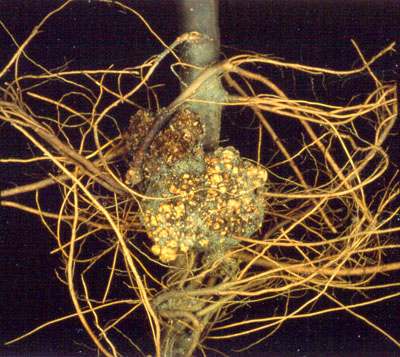Crown Gall, Root Gall & Hairy Root
General Description
Causal agent: Agrobacterium rhizogenes (Agrobacterium biovar 2)
This common, soil borne, bacterial disease attacks all types of orchard trees as well as a wide range of other plants. The bacteria are widely distributed in agricultural soils, and commonly spread by infected nursery stock.
Symptoms
Galls forms on the roots or crowns of trees, and rarely on aerial parts of the tree. Galls vary in size from several mm to 15 cm in diameter, and may be soft and spongy or hard. Small galls may be confused with callus tissue at wound sites, such as graft unions, or with galls caused by the root knot nematode. Heavy galling or galls that girdle stems may reduce the vigour of trees.
 |
| Crown gall on apple. (BCMA) |
Disease Cycle
Crown gall bacteria transfer part of their DNA into the host plant, resulting in a proliferation of disorganized plant tissue which appears as galls. The pathogen may spread from galls to healthy roots and soil. Infection occurs through wounds. The bacteria can also be spread with infected nursery stock or cuttings.
Management
Biological Control
Dygall (Agrobacterium radiobacter) is a biological inoculant, registered for control of crown gall in the nursery, on apricots, cherries, nectarines, peaches, plums, prunes, and pears. Dygall must be applied to susceptible plants or cuttings before planting in crown gall infested soil. Treatment will not cure existing galls or latent (symptomless) infections.
Immerse roots or cuttings in the Dygall solution just prior to planting. Keep the treated planting stock cool, prevent any exposure to sunlight, and plant as soon as possible. Follow precautions and directions on the product label.
NOTE: Dygall has not proven effective on apples, and is not registered for use on apples.
Cultural Control
-
Plant disease-free nursery stock, if available.
-
Do not plant trees with crown gall symptoms
-
Avoid injuring bark around the crown area when planting new trees.
-
When replanting orchard sites where crown gall has been a problem, remove as many old roots as possible.
-
Do not establish nursery plantings in soil with a recent history of crown gall.
Chemical Control
There are no chemical treatments for crown gall registered in Canada.
Updated January, 2017
